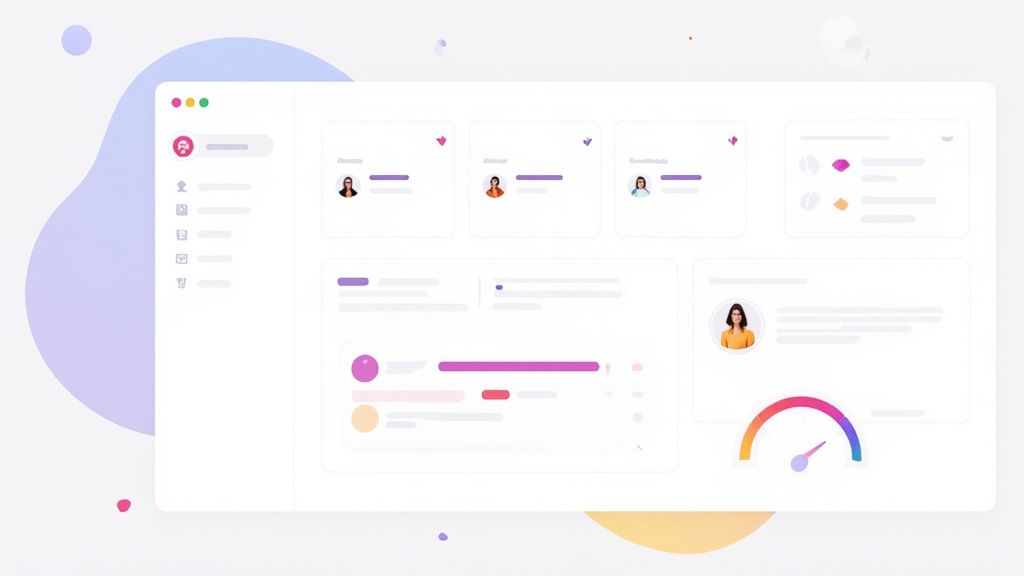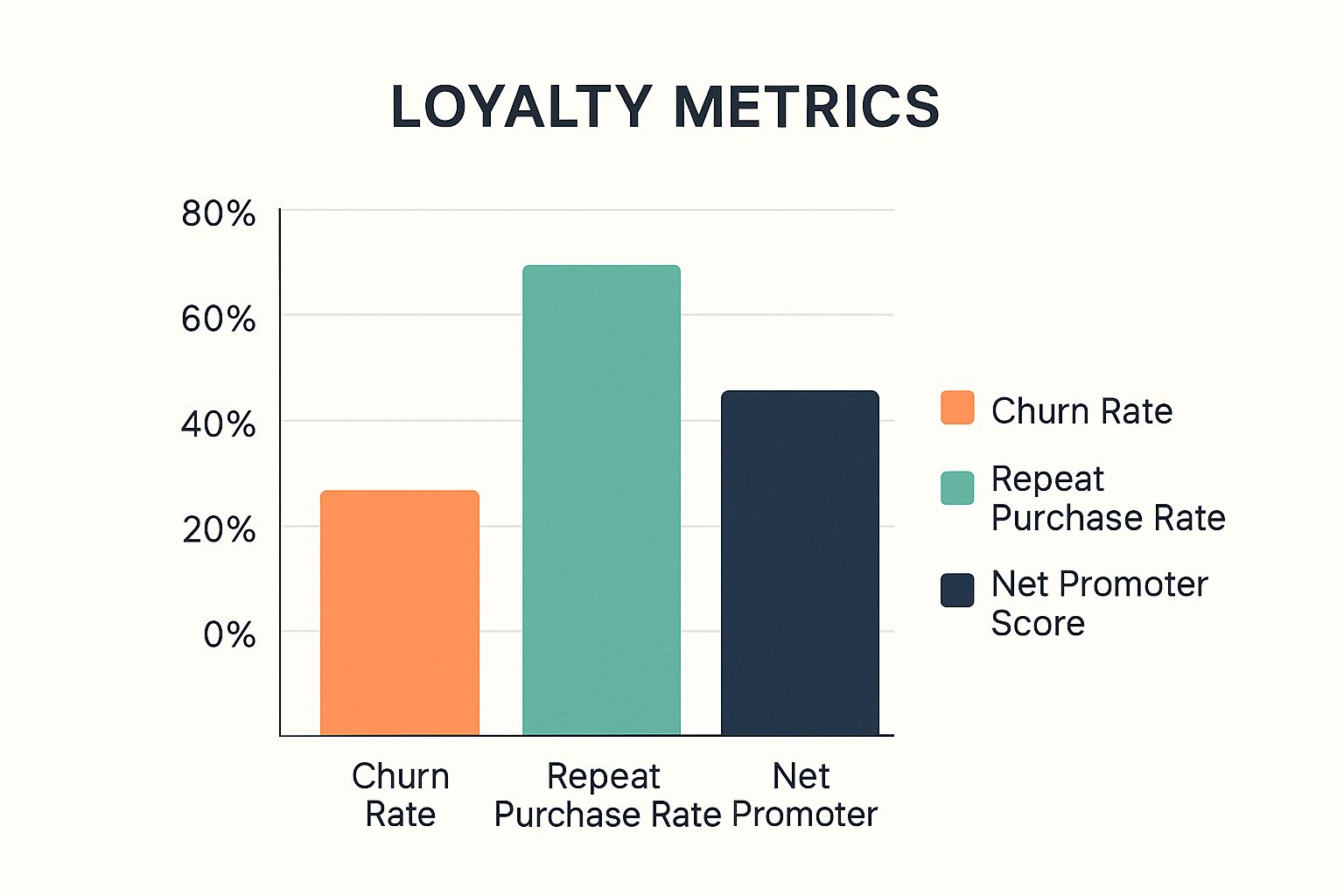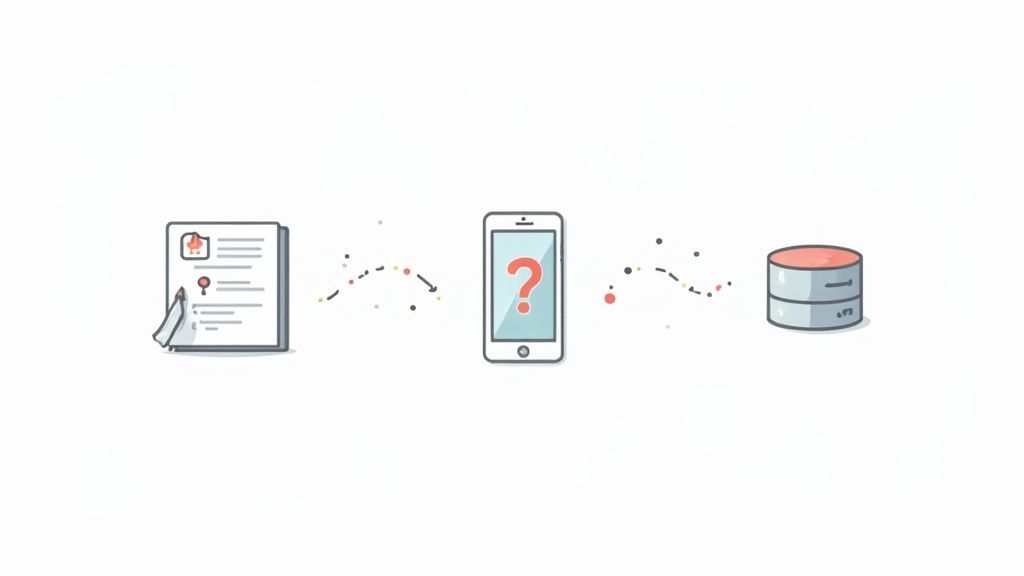Boost Business Growth with Customer Loyalty Analytics
Decoding the Modern Loyalty Analytics Landscape

Generic loyalty programs are a thing of the past. Successful businesses now recognize that customer loyalty analytics is essential for sustained growth. This means going beyond simply tracking transactions and adopting a more comprehensive understanding of the customer journey.
Instead of just focusing on customer spending, businesses are analyzing interactions across all touchpoints. This shift is fueled by the combination of big data and behavioral psychology, providing valuable insights into customer motivations. As a result, businesses can craft personalized experiences that cater to individual needs and preferences.
Understanding Customer Loyalty Segments
Effective customer loyalty analytics depends on segmenting customers into distinct groups. This targeted approach allows businesses to refine their strategies and maximize their impact.
One common method is segmenting customers based on their buying habits, using metrics like recency, frequency, and monetary value (RFM). Businesses can also segment customers based on their engagement with the loyalty program itself, such as reward redemption rates or participation in challenges.
This detailed understanding of customer behavior allows businesses to pinpoint their most valuable customers and develop specific strategies for each segment.
The Power of Predictive Analytics
Predictive analytics plays a crucial role in modern loyalty analytics. By using machine learning algorithms, businesses can predict future customer behavior with impressive accuracy. This proactive approach helps address potential problems and prevent customer churn.
For instance, a predictive model might identify at-risk customers based on recent activity or engagement patterns. This allows businesses to intervene with targeted offers or personalized messages to retain these customers.
Customer loyalty has become increasingly vital in the current economic climate. Trends from the Global Customer Loyalty Report 2025 highlight how consumers view loyalty programs as a way to access deals in exchange for their data. Discover more insights about the Global Customer Loyalty Report 2025.
The report also emphasizes the growing importance of personalized interactions. This personalization is a key element of effective loyalty programs, particularly during times of economic uncertainty. These programs can be a strategic asset for businesses to maintain customer engagement and retention.
Measuring the ROI of Loyalty Analytics
Measuring the return on investment (ROI) of your customer loyalty analytics initiatives is paramount. This involves monitoring key metrics like customer lifetime value, retention rate, and program participation.
By demonstrating the tangible benefits of loyalty analytics, businesses can secure stakeholder support and justify continued investment in these programs. Ultimately, effective customer loyalty analytics helps businesses cultivate stronger customer relationships, leading to increased profitability and sustainable growth.
The Metrics That Actually Drive Customer Retention

The infographic above highlights three core metrics for any successful loyalty program: churn rate, repeat purchase rate, and net promoter score (NPS). A lower churn rate, combined with a high repeat purchase rate and strong NPS, is a good starting point. However, truly understanding customer loyalty analytics involves a deeper dive. Simply measuring retention rates isn't enough. Leading organizations are developing more complex and insightful loyalty profiles. This enables a better understanding of what drives true customer loyalty.
Beyond The Basics: Advanced Loyalty Metrics
Building on essential metrics like churn rate, repeat purchase rate, and NPS, advanced loyalty programs utilize more nuanced data. This proactive approach helps identify warning signs of customer disengagement long before churn occurs.
One such metric is engagement velocity, which measures how quickly customers move through the various levels of engagement with your brand. A faster velocity suggests growing momentum and engagement. Conversely, a slower velocity could indicate declining interest.
Another valuable metric is emotional loyalty scores. These scores aim to quantify the emotional bond a customer has with a brand. Analyzing customer feedback, social media sentiment, and even facial expressions can contribute to these scores. These seemingly subjective measures offer valuable insights into relationship strength.
Building Actionable Loyalty Dashboards
Businesses are now combining these metrics to build dynamic dashboards that inform decision-making across various teams. These dashboards centralize customer loyalty data, facilitating better collaboration between marketing, product, and customer service teams. For example, a sudden drop in engagement velocity within a particular customer segment could trigger a targeted marketing campaign.
To gain a clearer understanding of these metrics and how to apply them, check out this resource: How to master your customer retention metrics.
Quick Wins and Long-Term Strategies
Starting with easily accessible data points, such as website engagement and email open rates, can yield quick wins and early insights. These initial successes can help demonstrate the value of customer loyalty analytics and pave the way for more complex initiatives.
Measuring Relationship Depth
Relationship depth indicators assess the overall strength and duration of customer relationships. This can include purchase frequency, average order value, and the number of different product categories purchased. Each purchase strengthens the relationship, providing valuable data for analysis.
Analyzing these metrics helps businesses pinpoint their most loyal customers and tailor strategies accordingly. Exclusive rewards or early access to new products can further cement these relationships. By understanding and utilizing these metrics, businesses can evolve customer loyalty analytics from passive reporting into a powerful driver of growth and retention.
Understanding which metrics are most important for your business is key to building a successful loyalty program. The table below provides a summary of essential customer loyalty analytics metrics.
To help you choose the right metrics for your business, here’s a table outlining some key metrics for measuring customer loyalty:
Essential Customer Loyalty Analytics Metrics:
| Metric | Description | Calculation Method | Business Impact | Implementation Difficulty |
|---|---|---|---|---|
| Churn Rate | Percentage of customers who stop using your product/service over a given period. | (Customers lost during period / Total customers at start of period) * 100 | Indicates customer retention issues and potential revenue loss. | Easy |
| Repeat Purchase Rate | Percentage of customers who make more than one purchase. | (Customers with multiple purchases / Total customers) * 100 | Shows customer satisfaction and potential for long-term value. | Easy |
| Net Promoter Score (NPS) | Measures customer willingness to recommend your brand. | (% Promoters - % Detractors) | Reflects overall customer loyalty and brand perception. | Medium |
| Engagement Velocity | Measures how quickly customers progress through engagement levels. | (Change in engagement level / Time) | Identifies increasing/decreasing customer interest and potential churn risk. | Hard |
| Emotional Loyalty Score | Quantifies the emotional connection customers feel towards your brand. | Analysis of customer feedback, social media sentiment, etc. | Provides insights into brand strength and customer relationships. | Hard |
| Relationship Depth Indicators | Assess the strength and longevity of the customer relationship. | Analysis of purchase frequency, average order value, product categories purchased, etc. | Identifies most loyal customers and informs targeted strategies. | Medium |
This table provides a valuable starting point for building a comprehensive loyalty program. By analyzing these metrics, businesses can gain valuable insights into customer behavior and develop strategies to improve retention and drive growth.
Proving the ROI of Customer Loyalty Analytics

Convincing stakeholders to invest in customer loyalty analytics requires demonstrating a clear return on investment (ROI). This means providing concrete proof of its impact on the bottom line, not just stating the benefits. This section offers a framework for calculating and communicating the true business value of your loyalty initiatives.
Connecting Loyalty Metrics to Revenue
Demonstrating ROI hinges on directly linking loyalty metrics to revenue outcomes. For instance, track how increases in customer lifetime value (CLTV) correlate with investments in personalized loyalty programs. Also, show how improved retention rates, driven by data-driven loyalty initiatives, reduce customer acquisition costs. By showcasing these tangible financial benefits, you can build a stronger case for continued investment in customer loyalty analytics. Ultimately, this involves showcasing the direct impact of loyalty programs on revenue generation.
Real-world examples are often the best way to illustrate this connection. Consider a business using loyalty analytics to identify its top-tier customers. By offering these customers exclusive rewards and personalized experiences, the business can significantly increase their spending and, consequently, its overall revenue. This direct link between loyalty analytics and financial performance is a compelling argument for stakeholders.
Calculating the Compound Effect of CLTV
Further strengthening the ROI case involves demonstrating the compound effect of increased CLTV. This involves showing how even a small improvement in customer retention, driven by loyalty analytics, can lead to substantial long-term revenue growth. This is similar to compound interest, where small gains accumulate over time to produce significant returns. This long-term perspective is crucial for convincing stakeholders of the lasting value of customer loyalty analytics.
Moreover, statistics show that loyalty initiatives effectively drive business growth. Almost 70% of brands report increased customer engagement, while 58% see a boost in repeat purchases thanks to loyalty programs. This data highlights the effectiveness of loyalty programs in fostering deeper customer connections and driving tangible business results. For more detailed statistics, see Loyalty Program Trends. You may also be interested in: How to calculate the ROI of your loyalty and retention initiatives.
Adaptable ROI Models and Benchmarks
Presenting adaptable ROI models allows stakeholders to see how the principles apply to their specific business context, strengthening your argument. Providing realistic benchmarks based on industry and company size further enhances credibility. This tailored approach makes the potential impact of customer loyalty analytics more tangible and relatable for decision-makers. For instance, a smaller business might focus on increasing repeat purchase rates, while a larger enterprise might prioritize personalized offers based on predictive analytics.
Winning Internal Buy-in
Finally, sharing success stories from CMOs and CFOs who have championed similar analytics programs provides valuable social proof. These real-world examples demonstrate the practical benefits of investing in customer loyalty analytics. They offer a persuasive narrative for securing internal buy-in. These stories resonate with stakeholders by showcasing the tangible achievements of other businesses, making the potential benefits of loyalty analytics more believable and achievable.
AI-Powered Loyalty: Beyond the Buzzwords
Artificial intelligence offers significant potential for loyalty programs. However, it's important to distinguish true innovation from marketing hype. This section explores how successful companies effectively implement AI, focusing on practical uses of machine learning for customer loyalty analytics.
Predicting Customer Behavior With Machine Learning
Machine learning algorithms can predict future customer behavior with remarkable accuracy. These predictions are incredibly valuable for proactive customer retention strategies. For instance, predictive churn models identify at-risk customers based on past behavior and engagement.
This allows businesses to intervene with targeted offers or personalized messages, preventing churn before it occurs. AI can also personalize rewards and offers by analyzing customer data to determine the most effective incentives for each individual.
This maximizes engagement and return on investment. This personalized approach enhances the customer experience and strengthens loyalty. You might be interested in: How to use machine learning to improve customer loyalty.
Sentiment Analysis for Real-Time Relationship Management
Another powerful AI application for customer loyalty analytics is sentiment analysis. This technique analyzes customer feedback, social media activity, and other textual data to gauge customer sentiment towards a brand.
By detecting negative sentiment quickly, businesses can proactively address customer concerns and prevent damage to the relationship. This proactive approach is crucial for maintaining customer satisfaction and building loyalty.
This rapid growth is driven by AI-powered personalization, mobile-first engagement, and gamification across various sectors. The global loyalty programs market is projected to reach $93.79 billion in 2025 and $155.22 billion by 2029, exhibiting a CAGR of 13.4%.
Learn more about the growing loyalty programs market here. This expansion highlights the increasing importance of real-time engagement and data-driven strategies in improving customer retention.
Implementing and Scaling AI in Loyalty Programs
Implementing AI in a loyalty program requires careful planning. Begin with a clear objective and identify the specific problem you want AI to solve. Then, select the appropriate AI tools and techniques, ensuring you have access to sufficient data.
It's wise to start small, testing and refining your AI models before implementing them across your entire program. This measured approach allows for adjustments and improvements based on real-world performance and feedback.
Ethical Considerations and Building Customer Trust
While AI offers powerful capabilities for customer loyalty analytics, ethical considerations are paramount. Transparency and data privacy are essential. Customers must understand how their data is used, and businesses must adhere to data privacy regulations.
Building trust is fundamental for the long-term success of any AI-powered loyalty program. Prioritizing ethical data practices strengthens customer trust and ensures regulatory compliance, creating a sustainable and responsible approach to utilizing AI.
The Future of AI in Loyalty
The future of customer loyalty analytics is deeply connected to AI. As AI technology evolves, it will unlock even more advanced methods for understanding and engaging customers. From hyper-personalization to predictive analytics, AI will continue to shape loyalty programs.
This allows businesses to build stronger relationships with their customers. This ongoing evolution will empower businesses to create more effective and impactful loyalty programs that drive customer retention and sustained growth.
Crafting a Data-Driven Loyalty Machine

Effective customer loyalty analytics fuels successful programs. However, data without action is meaningless. This section explores how to transform these insights into a powerful loyalty machine. We'll cover structuring your operations for quick responses, creating personalized campaigns, and developing the right loyalty mechanics.
Structuring Your Loyalty Team for Data-Driven Action
High-performing loyalty teams are built for speed. They use automated intervention workflows triggered by specific data points. For instance, if a customer's engagement slows down, an automated email with a personalized discount can be sent. This proactive approach tackles potential churn before it happens.
Real-time dashboards offer a constant overview of key metrics. This allows teams to quickly adjust campaigns and strategies as needed. This constant monitoring ensures your loyalty program remains agile and responsive to customer behavior.
Personalized Retention Campaigns Based on Customer Segments
Analyzing customer behavior allows for personalized loyalty mechanics. Customer segmentation, based on purchase frequency and lifetime value, enables targeted retention campaigns. This could involve exclusive rewards for high-value customers or specific promotions to re-engage inactive customers. This focused approach maximizes the effectiveness of loyalty initiatives.
Balancing Short-Term Engagement and Long-Term Relationships
Effective programs balance short-term engagement with long-term relationship building. Short-term promotions can boost immediate sales. However, true loyalty requires a genuine connection. This involves understanding customer needs and offering value beyond discounts and rewards. It's about building trust and fostering a sense of community.
Testing, Measuring, and Scaling Loyalty Initiatives
Continuous improvement is crucial for any data-driven loyalty program. This involves testing different initiatives, measuring their impact, and expanding successful strategies. Think of it as a continuous feedback loop, allowing you to adapt and refine your approach.
By carefully monitoring results, you can identify what works best. This iterative process optimizes your program for maximum impact. It ensures you are focusing on strategies that resonate with your customers.
To help you further understand how to structure your loyalty program, let's take a look at a comparison of some common strategies. The table below outlines the key differences and provides insights into what might work best for your business, based on your size and available resources.
Loyalty Analytics Strategy Framework Comparison A comparison of different strategic approaches to customer loyalty analytics implementation across business sizes and industries
| Strategy Approach | Best For | Resource Requirements | Implementation Timeline | Expected Outcomes |
|---|---|---|---|---|
| Basic Points System | Small businesses starting out | Low | Short | Increased purchase frequency |
| Tiered Membership Program | Businesses with diverse customer segments | Medium | Medium | Higher customer lifetime value |
| Personalized Rewards with AI | Large enterprises with substantial data | High | Long | Improved customer retention and engagement |
This table highlights key factors to consider when developing your loyalty program. By implementing these strategies and continuously analyzing customer data, you can build a powerful engine for growth. This ongoing optimization is essential for attracting new customers and keeping existing ones engaged.
The Future of Customer Loyalty Analytics
Are you ready for the next evolution in loyalty? The landscape is constantly changing. This section explores emerging technologies and approaches poised to reshape customer loyalty analytics, preparing your business for the future of customer relationships.
Blockchain for Transparent Loyalty Ecosystems
Blockchain technology offers exciting possibilities for loyalty programs. Its inherent transparency and security can build trust between businesses and customers. Imagine a loyalty ecosystem where points and rewards are securely tracked and easily transferable between different programs.
This interoperability creates new opportunities for customer engagement and brand partnerships. Additionally, blockchain combats fraud and ensures program integrity, providing a secure foundation for future innovation. Its decentralized nature makes it extremely difficult to manipulate records, giving customers confidence in the program's fairness.
Emotional Analytics: Understanding Deeper Motivations
Emotional analytics delves into the emotional drivers of customer loyalty, moving beyond traditional metrics. By analyzing customer feedback, social media sentiment, and even facial expressions, businesses gain a deeper understanding of customer motivations.
This understanding informs more effective loyalty strategies. For example, if emotional analytics reveals a customer segment values exclusivity, businesses can tailor their programs to offer unique experiences and rewards, fostering stronger connections and building lasting loyalty.
The Rise of Zero-Party Data
As consumers become increasingly privacy-conscious, zero-party data is crucial for customer loyalty analytics. This refers to data customers willingly and proactively share with businesses. It allows for personalized experiences without relying on potentially intrusive tracking methods.
By giving customers more control over their data, businesses build trust and encourage greater loyalty program participation. This strengthens customer relationships and fosters transparency. It empowers businesses to tailor programs based on explicit customer preferences, further strengthening engagement.
Preparing for the Future of Loyalty
Leading organizations are actively preparing for these shifts in customer loyalty analytics. They are investing in new technologies like AI-powered personalization platforms and blockchain integration tools, gaining a competitive edge and adapting to evolving customer needs.
These organizations are also fostering a culture of data-driven decision-making, encouraging teams to gather and use customer data effectively at all levels.
By taking proactive steps today—implementing robust data governance, prioritizing ethical data practices, and investing in personalized experience technologies—businesses position their loyalty programs for long-term success. The future of loyalty is fostering genuine relationships built on trust, transparency, and a deep understanding of the customer.
Ready to build a future-proof loyalty program? Toki is an all-in-one platform empowering Shopify and other e-commerce merchants to create lasting customer relationships and drive repeat business. From tiered memberships and referral programs to advanced analytics and gamification, Toki provides the tools you need to convert casual shoppers into loyal brand advocates. Learn more about how Toki can transform your business at https://buildwithtoki.com.